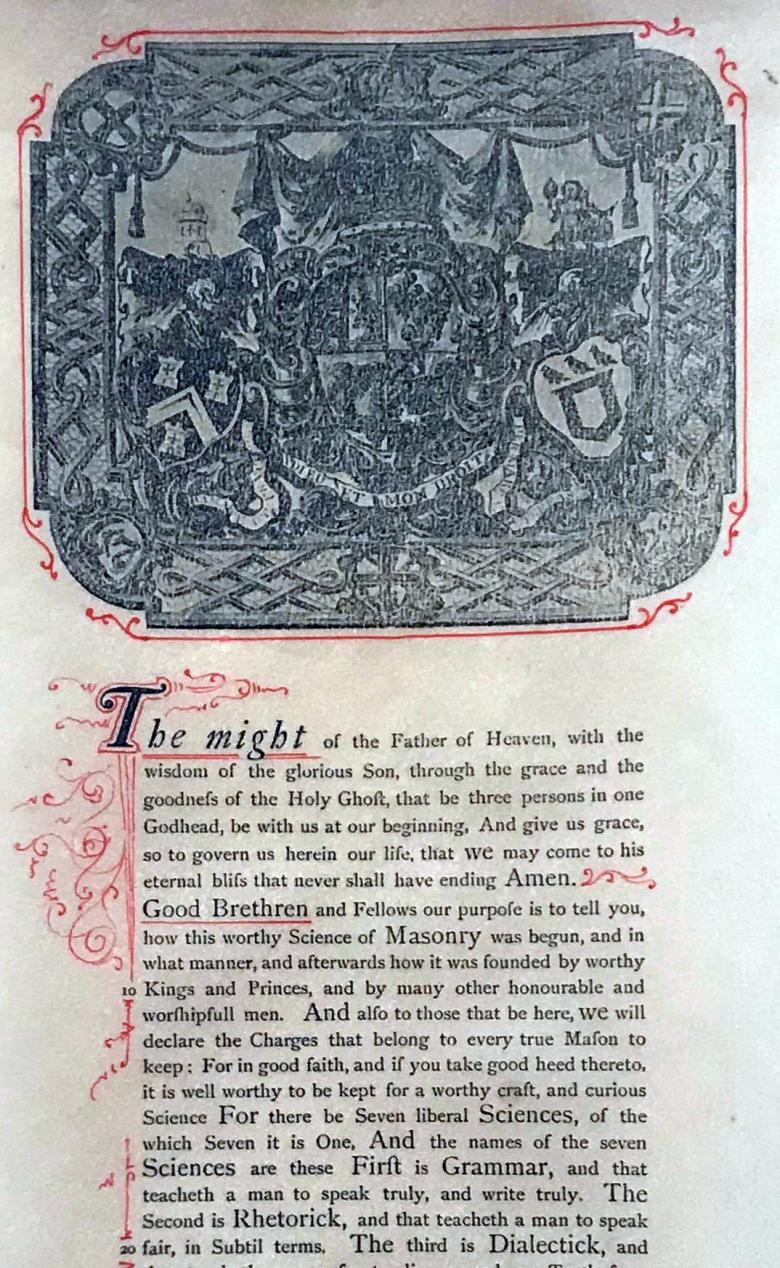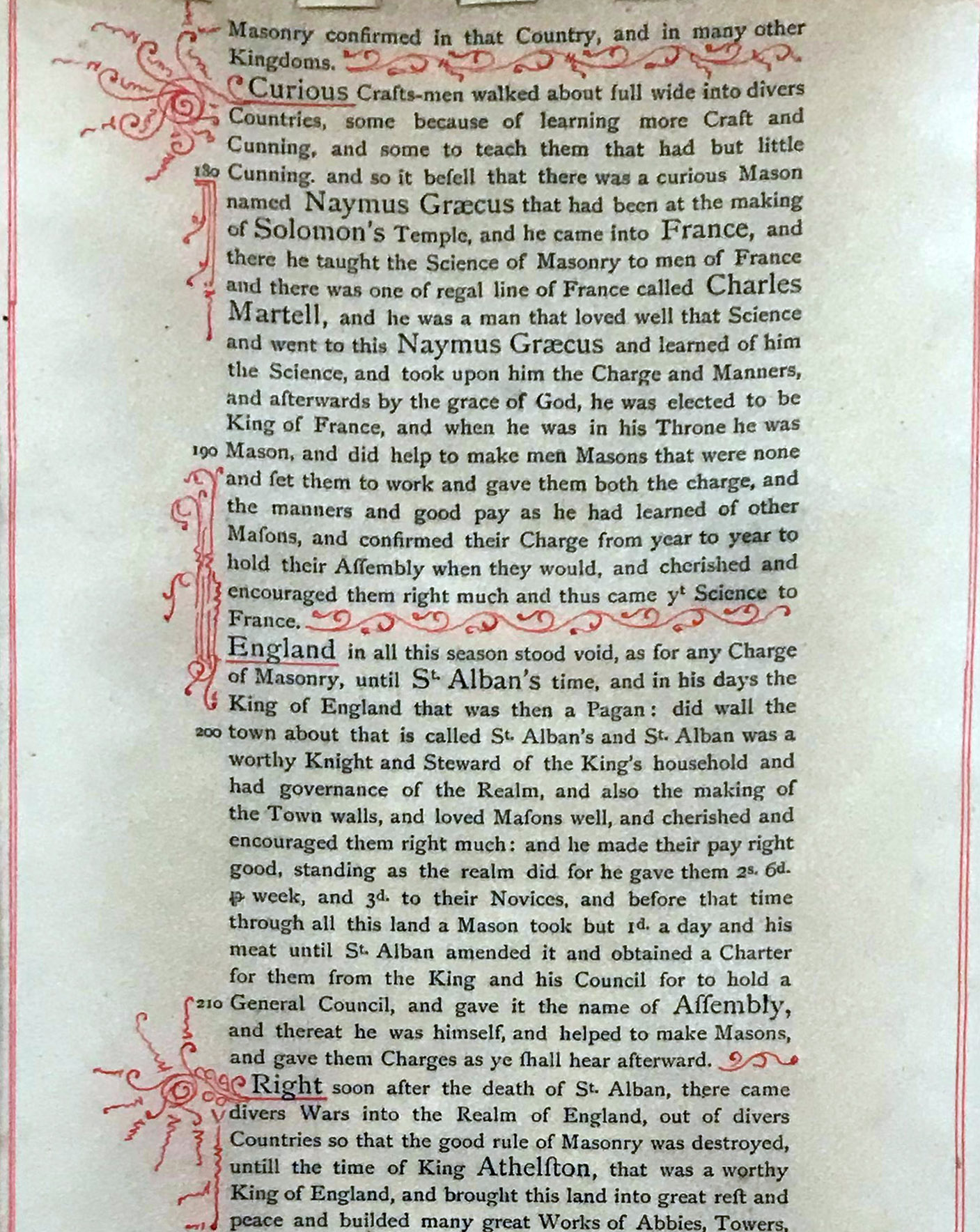"Old Charges" of the Freemasons


Some of our latest news
"Old Charges" of the Freemasons
This week's object is a very rare Old Charges manuscript, which is a reproduction by James Haddon, produced in the late 19th century on vellum. The size of the document is 16 by 210 cm. It is the only known full-format image of Haddon's manuscript on vellum. This copy is referred to by historians of Freemasonry, who are researching the subject of the Old Charges. The original Charges belong to the Grand Lodge of England and are in its museum in London.
It is believed that this particular version of the Charges is a slightly modernised copy of another, Colonel Clerke's manuscript, found in 1894 and dated with the year 1686. Colonel Clerke's manuscript traces the connection between the Worshipful Society of the Free-Masons of the City of London and the Speculative Masons' Lodge. That is - with today's form of Freemasonry.

This manuscript outlines the masonic Medieval constitutions, collected in 1723, which provide a historical context for basic Masonic principles.
It should be pointed out that the manuscript shows a coat of arms with the motto "Dieu et Mon Droit", which means "God and my right" in French. This is the motto of the British monarchy, that was used since the beginning of the 15th century and denotes the divine nature of the royal government. Moreover, this motto is still depicted on the Royal Coat of Arms of Great Britain. This fact indicates the loyal attitude of Freemasonry to the monarchy and Christianity and can even be interpreted as evidence of the conservative nature of regular Freemasonry, its close connection with the basic biblical values and noble spiritual principles, thus completely refuting modern conspiracies about Freemasons as instigators of bloody revolutions and opponents of religions.
But what are the Old Charges and what is their significance in Freemasonry? At its core, the Old Charges is a set of documents on which many Masonic principles are based. It is a collection of statutes and documents of the guilds of operative masons, consisting of about 130 texts and dating from the period between the end of the 14th century and the beginning of the 18th century. It is also important to note that the texts of the Old Charges were compiled in England, where the first Grand Lodge was subsequently founded in 1717.
The Old Charges are also known by the following names: "Old Constitutions", "Gothic Manuscripts", "Old Records", etc. The oldest document is dated by historians to 1390 and outlines the history of the masonic profession and the main duties of masons, also providing them with moral and ethical instructions.

It is in the texts of the Old Charges that one first encounters those rudiments that are now firmly associated with Freemasonry, such as the system of secret passwords and handshakes. But the manuscripts also contain the spiritual principles of the ancient guilds. Thus, the main requirements were the belief in the Triune God and loyalty to the monarchy.
It is important to note that the Old Charges also describe the structure of the operational lodges and the initiation rituals of the masonic guilds. Moreover, the Old Charges describe the legendary history of Freemasonry, dating back to King Solomon, and the rituals of initiation into the degrees of fellow-craft and master. The Old Charges also contain the oaths of medieval masons and the first mention of "free masons" - builders who had the right to travel freely and were not bound to local feudal rulers.
Thanks to this mythological history, that links the guilds of masons with ancient Greece and Egypt, as well as to the refined rituals with a deep moral and spiritual meaning, the masonic lodges gradually attracted people who were not professional builders but were looking for ways of spiritual self-improvement. It was in the Old Charges that the so-called speculative masons found an ancient and profound system of knowledge and ethics, hidden under an aura of mystery and allowing people with different political and religious views to unite.
Thus, during the 16th and 17th centuries, modern Freemasonry was actually born, which during a period of time synthesised the traditions of the Middle Ages with the ideals of Enlightenment humanism. As a consequence of this process, in 1723, under the authorship of James Anderson, updated rules of modern Freemasonry were published - "The Constitutions", which are based on the Old Charges, supplementing them with the ideas of the Enlightenment: religious tolerance, brotherhood and freedom.
Thus, the Old Charges can be considered as one of the prototypes of modern Freemasonry, containing ancient descriptions of the current rituals, degrees and even the basic ethical ideas of Masonic philosophy. However, it is worth emphasising that the documents comprising the Old Charges refer specifically to professional masonic guilds, not to the modern Freemasons. Moreover, the Old Charges were often mythologised in the Masonic environment, especially in connection with the ancient roots of the fraternity, which is typical of 18th century philosophers who looked for the roots of Enlightenment philosophy in antiquity.

 Museum
Museum